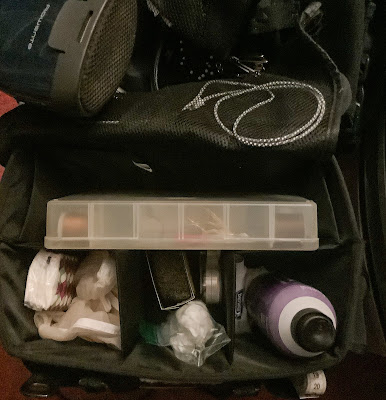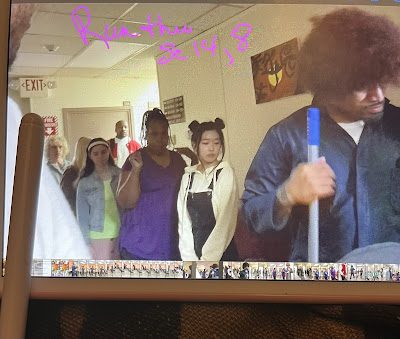I tend to describe myself as being anal creative … I love creativity and am always looking for ways to ”do it better/easier”. I try to seek ways to “do it better” while working on each project. Here are some of my tools/hacks:
My Styling/Costume Hacks
1) Use a packing list app … See my previous write-up (right column) on packing lists to learn more.
2) A flexible kit caddy - by Everything Mary (I altered a garment bag to add a cover.). The pivotal selling point for me was that the compartment configuration is adjustable.
 |
| How I configure the compartments |
3) A craft bin (shown in the above picture of the caddy) with adjustable dividers, to hold mini spools of thread and other sewing essentials.
4) A good handheld steamer is THE essential customer on-set tool. I did some research before deciding on one from Rowenta.
5) While I am never disappointed with my steamer’s performance, I still use Steamer Boost. It promises to release and keep wrinkles at bay while adding a nice fresh scent. It cuts down on the steaming time and that’s essential when on set.
6) A water bottle is important because it means less trips to refill my steamer, which tends to go through water quickly.
7) A luggage rack or foldable, wheeled, three-shelf cart are next on my list to hold the caddy and other items.8) Not everyone is a fan of makeup masks, but they do protect clothing.
9) I recently used a sweater stone (also shown in the middle, bottom compartment of the caddy) on set to return sweatpants, with a lot of pilling, to their “like new” finish.
10) Heat Hacks: A personal, usb fan with a self-standing base, helps with staying cool. I also like a spray mister for myself (Spraying water on a model/cast might put your health at risk with hair and makeup 😏.). Look into sweat guards and/or wipes to control perspiration stains.
11) I also like to include some first aid items in my kit; band aids, alcohol wipes, Tylenol, Benadryl & Neosporin creams, etc. It helps to quickly address minor issues/accidents.
Bonus) My New Favorite Tool: I created a customizable kit belt (after being frustrated with the standard aprons/belt on the market). I have tested the prototype when I subbed for the costume designer on a production. I made a few tweaks and retested. I will share once I apply for a patent.
Additional Costume Hacks
1) I prefer to use retail rack dividers to organize clothing by cast (larger, white dividers) and scenes. I purchased a thermal label maker primarily for this purpose, but it also works great with file folders and organizational, storage items.
2) My “peace of mind” hack is to use my iPad mini and pencil to log continuity shots. I use the iPad so I can the use the pencil to immediately write the scene number on the picture. This hack means there is no struggle to correctly match pictures with the corresponding scene later.
3) I learned to sew. I think this is major; I am often required to make alterations or temporary alterations. I would say a knowledge of, and comfort with, basic hand sewing is very important.I’ve worked on productions as the costume designer and, more often as a costumer (which I view as more on par with styling). I’ve done on-set, hand-sewn alterations on 99% of my projects … it’s definitely an expected skill.I didn’t have formal training. I researched and found some ebooks (Full Transparency: I didn’t do sewing exercises. I just looked at instructions for stitch techniques and tried several on my rework projects.). I watched a YouTube video to learn how to thread a bobbin to kick off getting comfortable with a sewing machine, which I use primarily for pre-production costume projects.
My commitment to making my reworks look as “well-done” as possible translates into many, many hours of practice (I’d say thousands of hours because the pieces were hand crafted.). The rest is history…
 |
| I got the hand sewing book because it’s my preferred technique. I like the control of hand stitching. |








